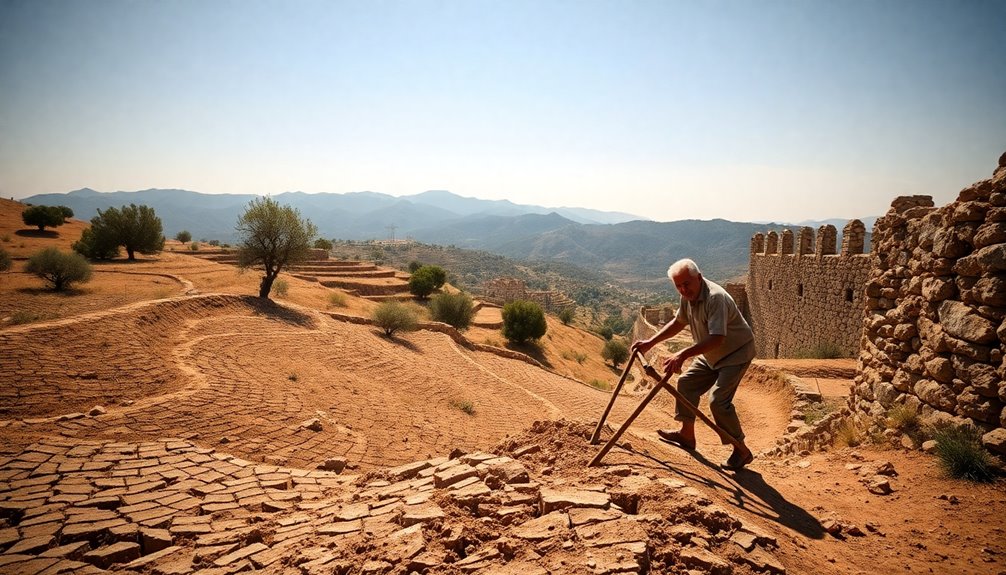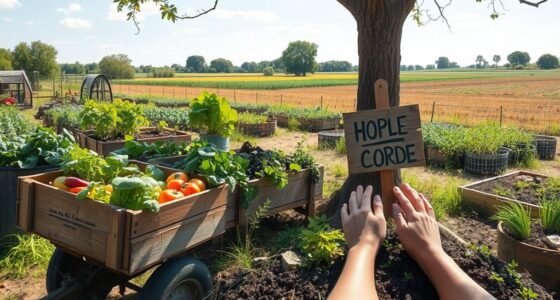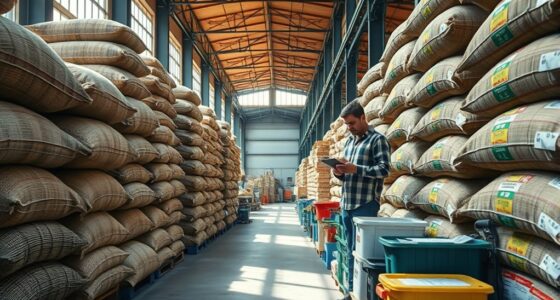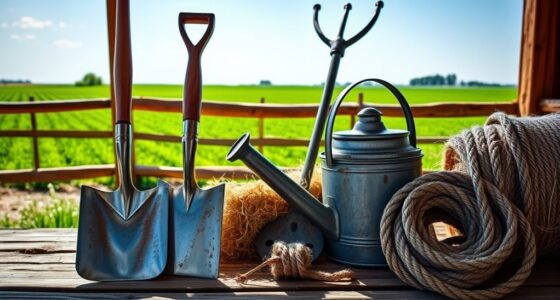Terrace farming has its pros and cons that you need to consider. On the upside, it maximizes arable land, boosts crop yields, and helps manage water effectively, all while preventing soil erosion. However, be aware that construction is labor-intensive and can be costly to maintain. You also face challenges like limited market access and climate risks. If you're curious about how terrace farming could benefit or challenge you, there's more to explore.
Key Takeaways
- Terrace farming enhances arable land on steep slopes, making it suitable for cultivating diverse crops like rice and potatoes.
- It effectively prevents soil erosion and manages water, promoting sustainable farming practices.
- However, initial construction and ongoing maintenance can be labor-intensive and costly.
- Limited access to markets and mechanization may hinder farming efficiency and profitability.
- Climate change impacts may pose long-term risks to crop yields, affecting future viability.
Understanding Terrace Farming
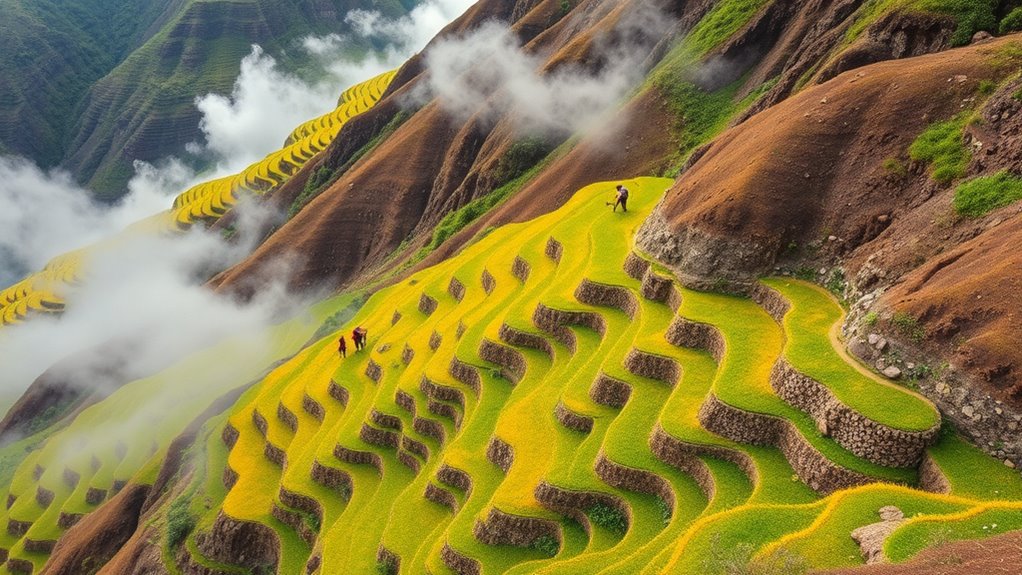
Terrace farming is a method where you create "steps" on sloped land to cultivate crops effectively. This technique is especially common in Asia, particularly in countries like Vietnam, the Philippines, and Indonesia, where rice is a staple crop.
You can grow a variety of crops such as potatoes and maize using this method. There are different types of terracing, including graded and level terracing, which cater to various landscapes.
Not only does terrace farming help prevent soil erosion and manage water effectively, but it also transforms idle hillside land into productive farms. By trapping rainwater, it supports water-intensive crops like rice, enhancing food security through increased crop yields.
Historical Significance of Terrace Farming
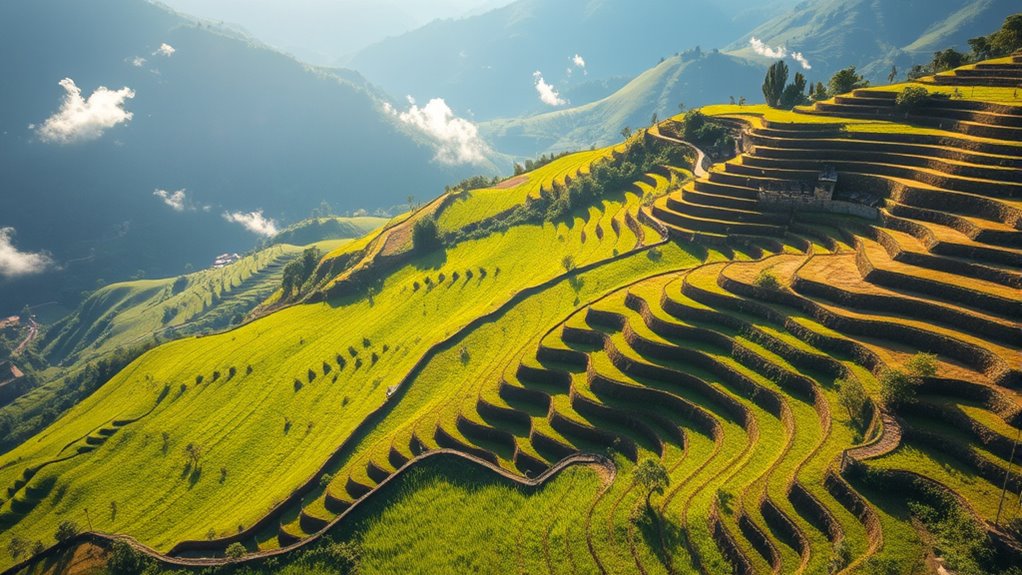
The historical significance of terrace farming reveals its profound impact on agricultural practices and cultural landscapes across the globe.
Terrace farming has shaped agriculture and cultural landscapes worldwide, highlighting its enduring significance throughout history.
You can trace its origins back to the Bronze Age in the Yemen Highlands, showcasing its ancient roots. The Hanging Gardens of Babylon and Inca innovations in the Andes exemplify how terracing evolved to meet agricultural needs.
In Asia, especially in Vietnam and Indonesia, terracing has been crucial for rice cultivation. This method not only promotes crop diversity but also preserves cultural traditions in communities relying on these practices.
The Rice Terraces of the Philippine Cordilleras, a UNESCO World Heritage Site, highlight the cultural importance of terraces, fostering social bonds and supporting local economies through heritage tourism.
Advantages of Terrace Farming
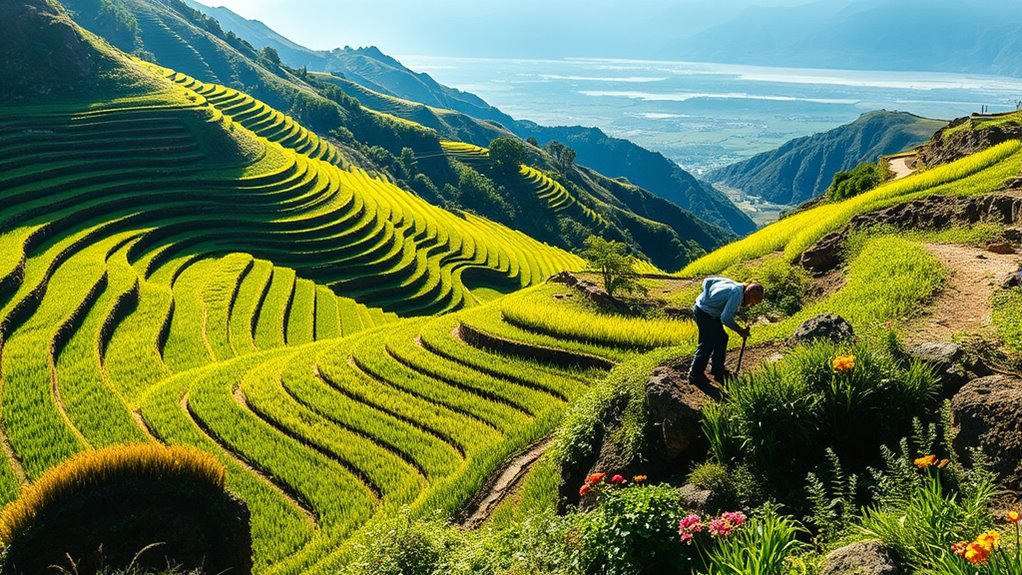
While many agricultural methods face challenges in steep terrains, using terrace farming offers numerous advantages that can significantly enhance productivity and sustainability.
By transforming steep slopes into arable land, you can increase the area available for farming. This method not only boosts crop yields but also ensures safer growing conditions, enhancing food security.
Terracing slows water runoff, allowing better rainwater harvesting and reducing soil erosion, which helps maintain soil fertility.
You'll also enjoy increased farm income through optimized land use and diversified crop options.
With well-maintained terraces, you can elevate your property value while supporting local biodiversity.
Disadvantages of Terrace Farming
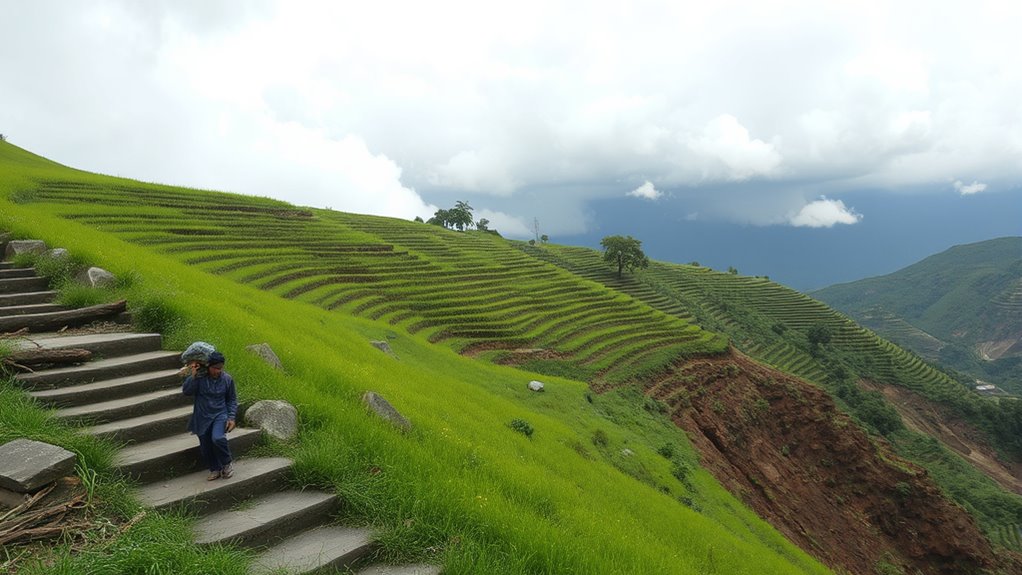
Though terrace farming offers several benefits, it also comes with a range of disadvantages that can impact its viability.
First, constructing terraces is labor-intensive and often demands a high initial investment, which can strain your resources. You'll also face ongoing maintenance costs, as terraces require regular upkeep to prevent erosion and ensure their stability.
Additionally, the risk of soil saturation and landslides can threaten your crops and livelihood. Limited access to markets and mechanization can further complicate your farming efforts, especially if you rely on local labor.
Lastly, climate change poses a risk to your yields, making long-term planning essential. These challenges can make terrace farming a significant commitment that not everyone is prepared to undertake.
Ideal Crops for Terrace Farming
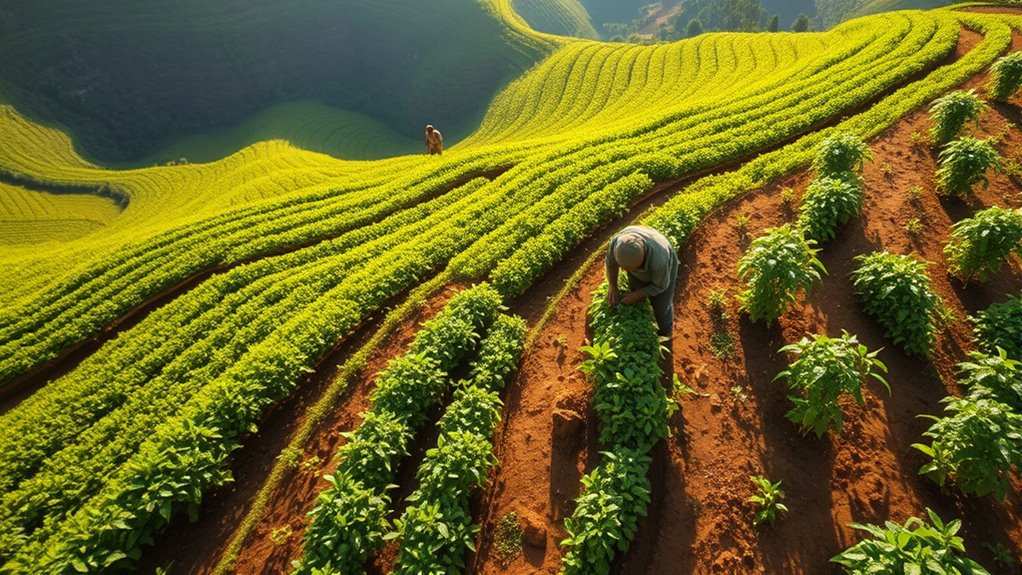
Choosing the right crops for terrace farming can significantly enhance your yield and sustainability. Focus on grains like rice, wheat, and maize, as they thrive in terraced conditions.
Legumes such as beans and lentils improve soil fertility while providing nutrition. For fruits, consider apples, grapes, and passion fruit, as they adapt well to varying climates.
Vegetables like potatoes, lettuce, and spinach are also excellent choices. Don't forget about herbs and spices; saffron and black cumin can add value to your harvest.
Tailor your crop selections based on regional suitability and soil requirements, ensuring optimal growth. Implementing crop diversity and rotation can further maximize your productivity and soil health, making your terrace farm more resilient.
Environmental Impact of Terrace Farming
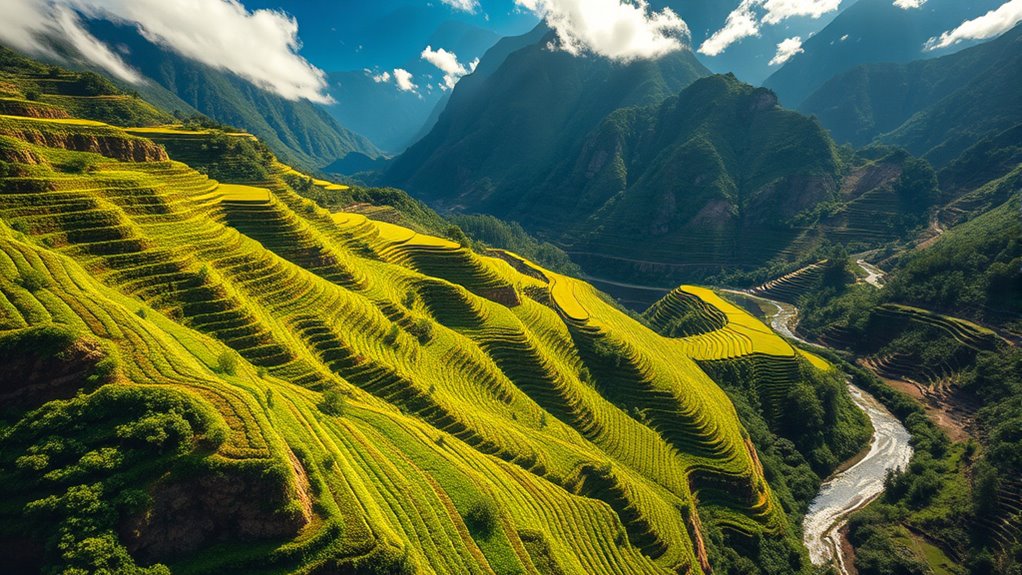
Terrace farming not only optimizes crop yield but also plays a significant role in environmental conservation.
By slowing water runoff, terraces significantly reduce soil erosion, protecting the nutrient-rich topsoil vital for healthy crops. They help retain moisture, preventing nutrient loss and enhancing soil fertility.
Additionally, terracing minimizes sediment runoff into nearby water bodies, contributing to cleaner ecosystems. This method controls water flow and conserves water by storing runoff, which can be crucial during dry spells.
Moreover, terracing supports biodiversity and maintains ecosystem services, fostering resilience against environmental changes.
While it may initially disturb soil layers, the long-term benefits of improved soil health and reduced erosion make terrace farming an environmentally friendly choice for sustainable agriculture.
Modern Tools and Technologies for Terrace Farming
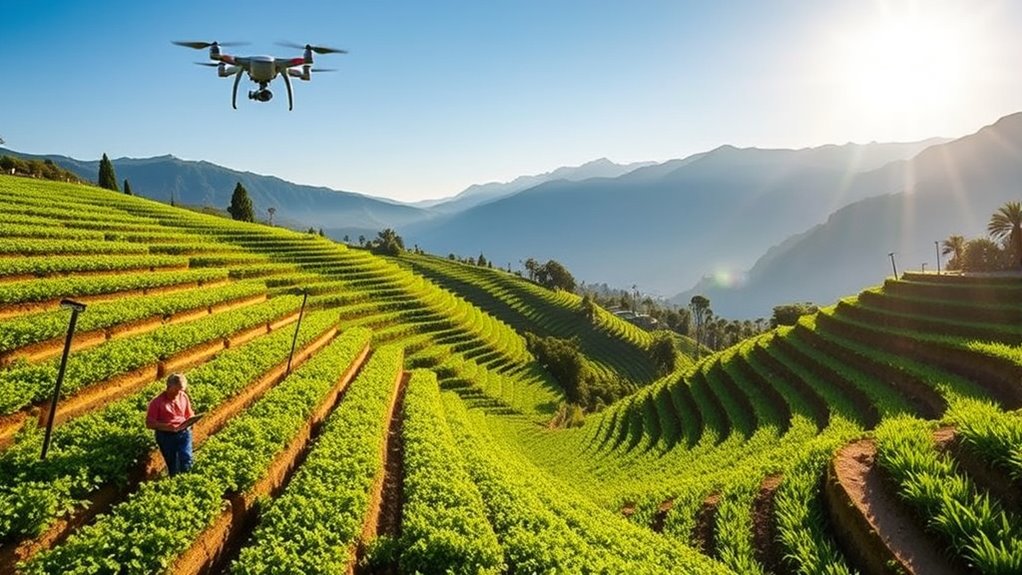
In today's world, farmers are increasingly turning to modern tools and technologies to enhance their terrace farming practices.
Precision agriculture software uses AI to analyze soil health and weather patterns, optimizing planting and harvesting. IoT-based smart irrigation systems automate water distribution based on real-time soil conditions, preventing overwatering.
Harness AI-driven precision agriculture and smart irrigation to optimize your terrace farming for healthier crops and efficient water use.
Drones play a crucial role, providing aerial monitoring of crops and soil, enabling timely interventions. Data analytics offers valuable forecasts on weather and soil erosion risks, guiding your farming strategies.
Additionally, digital farm management platforms simplify financial and inventory tasks, while blockchain enhances transparency in supply chains. With the implementation of automation's role in improving data analysis, you can improve efficiency, sustainability, and ultimately, profitability in your terrace farming endeavors.
Evaluating Whether Terrace Farming Is Right for You
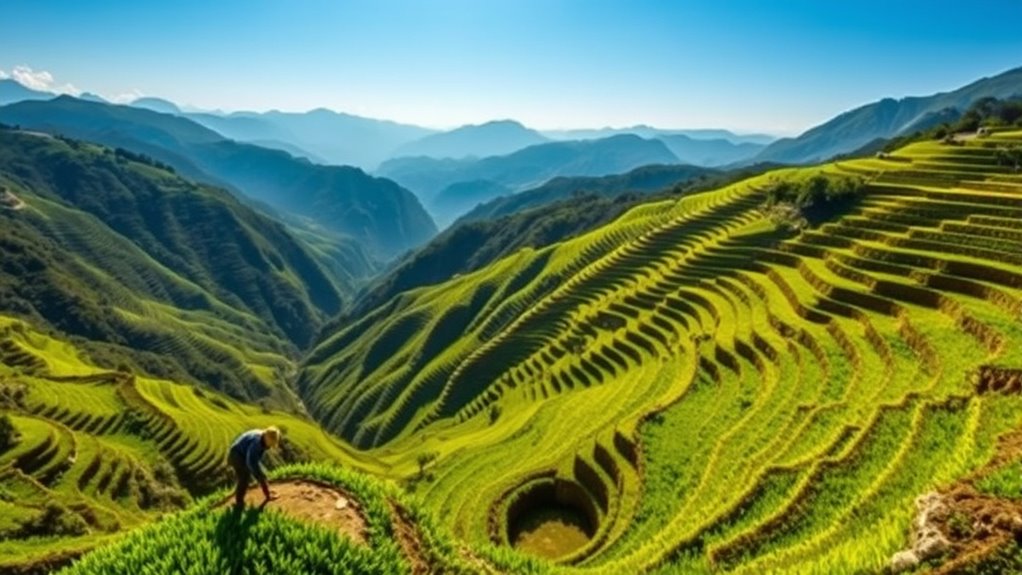
How can you determine if terrace farming is the right fit for your agricultural goals? First, consider your geographical situation. If you're in hilly or mountainous areas, terrace farming might be ideal.
Next, evaluate the crops you wish to grow. Terrace farming supports plants like rice, maize, barley, and potatoes, which thrive in such environments.
Keep in mind the initial investment and ongoing maintenance costs; terracing can be labor-intensive and costly but may increase your land's productivity.
Additionally, think about the environmental benefits, such as soil conservation and water management.
Lastly, assess cultural significance and community involvement, as these factors can enhance your farming experience.
Ultimately, weigh these elements to make an informed decision.
Frequently Asked Questions
How Much Land Is Needed for Effective Terrace Farming?
To determine how much land you need for effective terrace farming, consider your land's topography and slope.
You'll require enough space for terraces that accommodate your chosen crops, ensuring proper spacing and drainage. The specifics depend on factors like soil type, climate, and the scale of your operation.
Generally, you should design your terraces to follow the land's contour, optimizing both space and productivity while preventing soil erosion and conserving nutrients.
What Is the Best Climate for Terrace Farming?
Did you know that terraced farming can increase crop yields by up to 50% in suitable climates?
For effective terrace farming, you'll want moderate to high rainfall areas, as they help retain moisture. Both cool and warm climates can work, depending on your crops.
Look for well-draining, moisture-retaining soils and consider the altitude—high regions like the Andes are prime spots.
Sunlight exposure also plays a key role in your success.
Can Terrace Farming Be Combined With Other Agricultural Methods?
Yes, you can definitely combine terrace farming with other agricultural methods to enhance your productivity.
By integrating crop rotation, advanced irrigation systems, or organic practices, you'll improve soil health and water efficiency.
Adding agroforestry can boost biodiversity, while precision agriculture tools can optimize your crop management.
This combination not only increases yields but also promotes sustainability and resilience against climate change, making your farming approach more effective and diversified.
How Do I Start Building Terraces on My Land?
Starting to build terraces on your land is like crafting a beautiful staircase in nature.
First, assess your slope to determine the terraces' size and number. Choose sturdy materials for retaining walls, then dig trenches and construct your walls, ensuring they're stable.
Move soil to create level surfaces and add drainage systems to prevent erosion.
Finally, maintain your terraces with regular inspections and select plants that help stabilize the soil.
What Are Common Pests in Terrace Farming?
In terrace farming, you'll encounter common pests like aphids, caterpillars, cutworms, flea beetles, and tarnished plant bugs.
These pests can damage your crops significantly, so it's essential to stay vigilant. You can control them through crop rotation, encouraging natural predators, or using neem oil sprays.
Hand-picking pests is another effective method. Remember, maintaining healthy soil and proper water management can also help keep pest populations in check.
Conclusion
In conclusion, if you're considering terrace farming, it's essential to weigh the pros and cons carefully. You might find that the historical significance and environmental benefits resonate with your values, while the potential challenges spark curiosity. Coincidentally, the ideal crops could align perfectly with your local climate and soil conditions. By embracing modern tools, you can turn your terrace into a thriving garden. So, why not give it a shot? You might just discover your green thumb!



